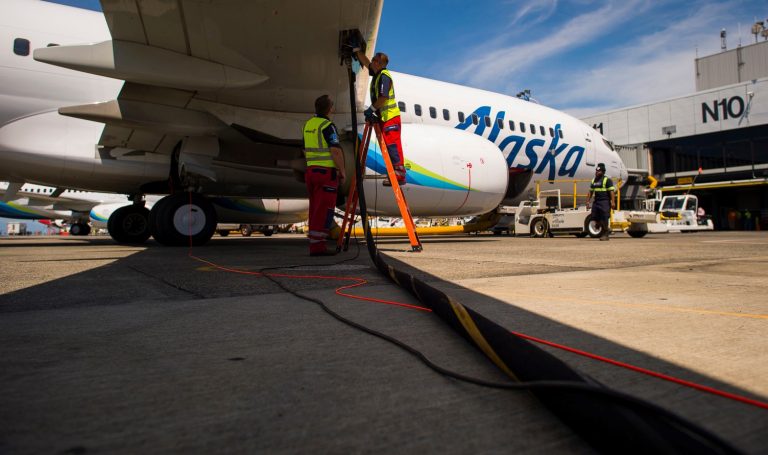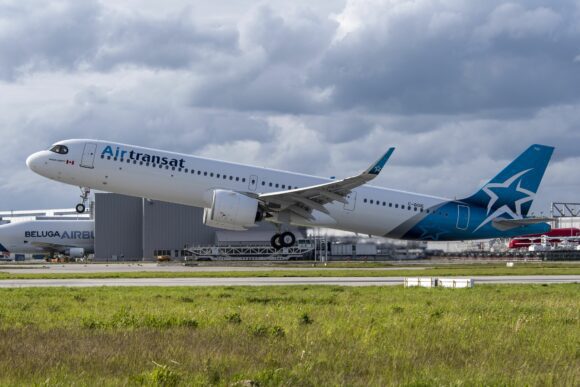
ASFueling3 e1618404384773 768x455 1
UPDATE – The quest for more sustainable aviation fuels (SAFs) in North America has received a boost this week. On July 14, Boeing announced a partnership with SkyNRG Americas on scaling up the availability and use of SAFs on a global level. At the same time, Boeing will invest in the production capacity in the Pacific Northwest. On the 15th, Airbus said that it will support the new Canadian SAF+ Consortium. SAF initiatives get a boost from Boeing and Airbus.
“Boeing is providing investment in the form of advance payments and fuel procurement commitments to SkyNRG Americas in support of our initial SAF facility. Boeing will use the SAF provided by SkyNRG Americas for flight tests and other operations”, says John Plaza, CEO of SkyNRG Americas. Boeing has been using SAFs since 2008 and helped them gain commercial approval in 2011.
By origin, SkyNRG is an Amsterdam-based company that was formed ten years ago to pioneer SAFs in aviation. It sources, blends, and distributes SAFs to over thirty airlines across the world. Currently, most of its SAFs are sourced from the bio-refinery of World Energy (previously AltAir) in Paramount (California), from where it is shipped to Europe. In the past years, SkyNRG has built its supplier and distribution network as well as forming coalitions with leading industrial partners and airlines like KLM, SAS, and Finnair. SkyNRG plans to open its own bio-refinery in the Northeast of The Netherlands, capable of producing 75.000 tons a year.
Evaluation of first production site under way
SkyNRG Americas was formed as a joint venture company. Based in Bend (Oregon), it plans to build a network of regional direct supply lines or DSL units in North America, including the US and Canada. A number of production facilities are planned, with the location of the first one on the US West Coast being evaluated. The plan is to offer SAFs to airports in Portland, Seattle, San Francisco, Los Angeles, and Vancouver.
“Our initial pioneer facility is anticipated to produce around ten million gallons per year by 2026”, says Plaza. “SkyNRG Americas is pursuing a pure waste-based SAF strategy for our production assets. The feedstocks for our SAF production will be low value, organic waste streams from landfills and other sources along with renewable electricity for green hydrogen. These SAF production technologies will be licensed from technology providers including LanzaTech and LanzaJet for production of SAF using Alcohol-To-Jet (ATJ) technology.”
In this ATJ process, ethanol is converted into synthetic paraffinic kerosene (SPK) using four different steps. The end product is blended with conventional kerosene, as current regulations only allow a maximum of fifty percent SAFs to be blended. On its ecoDemonstrators, Boeing has used 100-percent SAFs that are likely to be certified in the coming years. Depending on the ethanol source, blended SAFs reduce greenhouse emissions by some seventy percent as it re-uses CO2 that has been stored in the feedstock before.
In Europe, LanzaJet already works together with SkyNRG in the FLITE program. Last February, British Airways announced it will invest in the Chicago-based company, as did Shell in April, while All Nippon Airways is already a partner. LanzaJet itself will build a new refinery with a capacity of ten million gallons in Soperton (Georgia). The Freedom Pines Fuels is set for completion next year. The SkyNRG Americas first facility will likely be a copy of this LanzaJet plant as it uses the same technology.
The new SAF-refinery of Fulcrum in Nevada. (Fulcrum)
Fulcrum BioEnergy has just completed the construction of its Sierra BioFuels Plant in Reno (Nevada), which is capable of producing eleven million gallons of SAFs annually. It is expected to begin production in the final quarter. United Airlines, Cathay Pacific, and Japan Airlines are strategic partners of Fulcrum.
SkyNRG Americas announced a Memorandum of Understanding in April with Alaska Airlines, the first airline to partner with it. As the partnership with Boeing, Alaska will help SkyNRG with the development of production facilities on the West Coast but definitely intends to source SAFs once available. Alaska might be the first, but definitely not the last airline to cooperate with SkyNRG Americas, says John Plaza: “We are in discussions with other potential customers beyond Alaska Airlines and Boeing but nothing has been announced. We will be sure to share this with you if/when further announcements are made.”
Airbus joins Canadian SAF+ Consortium
Another SAF initiative got a boost from Airbus. On July 15, the airframer announced an MoU with the Canadian SAF+ Consortium on the development and production of sustainable aviation fuels in North America. Hailed as a new ecosystem, the project connects the OEM with aviation industry players in the Quebec region to make low-carbon flying a reality.
Airbus will provide technical and certification expertise, economic analyses, plus offering its communication network.
The consortium plans the construction of a pilot plant that will produce Power-to-Liquid (PtL) SAF. This is a synthetic fuel made through direct capture of carbon dioxide from industrial sources. The CO2 is synthesized with hydrogen that is produced using green electricity to form liquid hydrocarbons, which are the basis for a synthetic fuel equivalent to kerosene. Various initiatives of direct capture are tested across the globe. PtL SAFs are only ‘green’ when the electricity needed to produce hydrogen is also coming from natural sources, like solar, wind, or water energy.
The pilot plant east of Montreal is set to produce the first SAF already this year, leading to full-scale production of 30 million liters in 2025.
The SAF+ Consortium consists of Hydro-Quebec, Aeroports de Montreal, Aero Montreal, Polytechnique Montreal, and Air Transat. The airline has committed itself to use SAFs on its Airbus fleet.
SAFs developed for decades
SAF or biofuels have been under development for decades. The first commercial flight using twenty percent babassu or coconut oil was done in February 2008 by Virgin Atlantic with a Boeing 747 between London and Amsterdam. The availability of SAFs has been very limited and its use is currently only 0.01 percent of all jet fuel that is required. While IATA and ICAO have adopted resolutions to promote SAFs, the lack of incentives and clear mandates have prevented a breakthrough.
Wednesday’s Fit for 55 policy package of the European Commission could be a catalyst, although critics like IATA say it lacks incentives for companies to actually produce more SAFs. In May, the Sustainable Skies Act was sent to the US Congress to support the use of SAFs.
While hydrogen is seen as the real option to get to zero emissions in 2050 and Airbus is putting its weight behind a hydrogen airliner for the mid-2030s, all experts agree that sustainable aviation fuels are essential to bridge the gap until hydrogen is available. The IATA and ICAO resolutions adopted in 2018 state that no SAFs may be produced using food and other green feedstock that adversely affect biodiversity or food production.
Views: 6





